The last oddball at the Indianapolis Motor Speedway
Part 6: Final reflections
Author
- Henri Greuter
Date
- December 17, 2008
Related articles
- March-Porsche 90P - The last oddball at the Indianapolis Motor Speedway, by Henri Greuter
- Introduction
- Part 1: About oddballs
- Part 2: The road towards the 90P
- Part 3: The design
- Part 4: Performance evaluation (1)
- Part 5: Performance evaluation (2)
- Part 7: Specifications
- Part 8: Results
- Part 9: Insights about the 90P from one of its designers
- March-Alfa Romeo 90CA - Fiasco Italo-Brittanico, by Henri Greuter
- Porsche - Weissach's single Grand Prix win, by Mattijs Diepraam/Felix Muelas
Who?Teo Fabi What?March-Porsche 90P Where?Indianapolis When?1990 Indianapolis 500 |
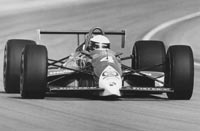 |
Why?
The Pancake, revolutionary as it was, had been handicapped due to all kind of mishaps. I can't produce definitive evidence to support the following thought but somehow I can't help feeling that the 90P concept's heritage and origins (Porsche) was a handicap to begin with. For example, the use of all-carbon monocoques was indeed allowed from 1991 on and such cars were indeed built. But only a year earlier the permission for such cars was hastily reversed…
Somehow, it seems the fact the 90P was partly Porsche didn't help one single bit, if not for the opposite. Politics weren't applied against the team as long as it wasn't too successful but once the first signs of the team's competitiveness became apparent, the attitude towards them appeared to be changing. Maybe if Porsche had made engines available to other teams as well the sentiments about Porsche's participation may have been different but the exclusivity of both chassis and engine as well as Porsche's reputation as a dominating force in other series eventually seems to have worked against them.
If all of that wasn't enough, the team suffered from other setbacks and thus was unable to use the experiences gained with the 90P in later years.
Team general manager Derrick Walker stated at the end of the season: "It is difficult to pinpoint one major problem. But if you had to pick one single era it would have to be the complexity of the 90P. We aimed for a big gain and, due to getting such a late start, were unable to develop it. However, our engine development program did make some giant steps forward."7
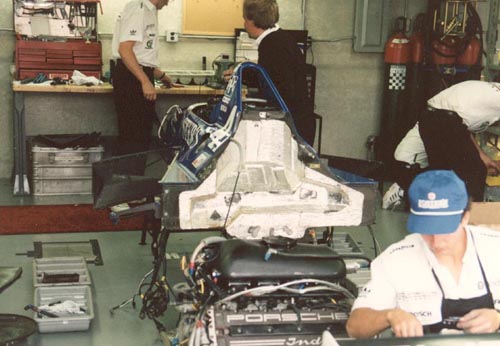
A better view of the monocoque's rear side. One almost wonders how the entire chassis-engine structure could be made rigid enough to withstand torsion. (photo HG)
Its design features didn't convince any other competitor of trying the same approach in their attempts to create an aerodynamically clean machine. No other CART car ever had a turbocharger at any place other than behind the engine, in front or above the rear axle. Due to the handicaps the car suffered from since the very beginning and the fact that Porsche withdrew from CART we will never know if the option had been more useful as to how things appeared initially. One may have concerns about the results of the unusual location of the exhaust gasses, above of the left sidepod. What did this do to the aerodynamics for example? A prominent team member told me tests had revealed that the problems were lesser than expected, although the cars did need the off-beat exhaust pipes to minimize the effects.
According Karl Ludvigsen, the car initially handled so badly that engineers suspected the exhaust flow was affecting the rear wing. The car was then tested with a pipe to direct the gasses under the rear wing. This proved that the gasses were not the problem. Eventually a modification of the upper bodywork cured the handling problem.6
All season long the team had to make up ground to sort their car out instead of having done so before the start. And that with a car that was destined to be on the weight limit instead of very much overweight. The car went through some 140 modifications of all kinds. But the team never caught up with the early-season setbacks after they were forced to rebuild and redesign the chassis.6
All this makes the Pancake and the car's concept a case of unfulfilled promise. Who knows how big the compromised eventual result may have been if it had been perfected by a team knowing it would be in business the following season. And how competitive would the follow-up have been which would have been allowed to use the much-desired all-carbon 'coque could? It appears the 90P became a victim of politics within both CART as well as Porsche management. On top of that, chassis partner March had its own troubles to deal with. Not quite the healthy situation needed for the development of a revolutionary car.
Maybe my verdict of unfulfilled promise is too optimistic for some. Arguably, the same could be said of a number of principles used on the 1986 Brabham BT55 F1 car which failed miserably. But two year later, when McLaren raced the MP4/4 using principles found on the BT55 two years earlier it worked with results rarely seen before or ever since.

Another view of the 90P at speed. (photo HG)
Given the claimed progress on the engine, one could also wonder how competitive a more conventionally designed Porsche-powered CART machine might have been. Whatever is written about the March-Porsche 90P, the engine rarely gets negative comments.
Robin Herd, having left March before being hired by Porsche team manager Derrick Walker, told Karl Ludvigsen that the car initially had problems with the oil tank's internal contours, causing the tank to swallow air. Herd also mentioned that the car was too pitch-sensitive on the ovals, though this could be sorted out. Furthermore, he stated it would have been better if the new-for-1990 car had been inspired on the 89P, thus improving a proven design. But since that was basically the Alfa Romeo-powered 90CA, maybe that was not such a good idea after all.6
Regrettably, an updated Porsche Indy V8 fitted in a 1991 Lola never got the chance to show what it was capable of, but it could have been a competitive proposition. But had Porsche remained in CART other problems were lurking ahead, engine-related ones to be precise.
The seeds for yet another new aerodynamic trend were sewn in 1991 when Ford worked on the replacement engine for its ageing Cosworth DFX and DFS derivatives to fight the Chevrolet Indy V8. The new Ford Cosworth XB introduced in 1992 was the first of the new brand of shoebox-sized engines. From then on, engine blocks became smaller and smaller and the cars in which they were built morphed into ever more lower shapes. It defies imagination how the 90P would have looked if the tiny V8s built for CART since 1992 had already existed. There is no doubt that to remain competitive Porsche also would have had to build such a shoebox-sized engine to replace their late 80s V8 design.
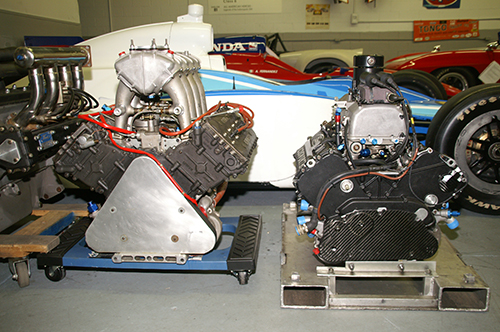
I admit, it isn't the best enviroment to take pictures like this but sometimes you can't complain when you have the chance to see the real things next to another. On the left is a Ford Cosworth DFX engine, an engine that was about the same size as the Porsche Indy V8. On the right is a Ford Cosworth XB engine that was introduced in 1992. The difference in frontal area and bulk is clear to see. As tiny as the 90P was, an XB would have felt lost in the engine bay of the 90P This picture was taken in June 2013. (photo HG)
And Porsche building a compact engine? They did it with the TAG Turbo V6 F1 engine but the F1 V12 that was partly responsible for the end of the career of the Indy V8 was everything but compact and eventually became much more of an embarrassment to the company than any of the Porsche-powered Indycars ever managed to.
Porsche's withdrawal from CART also meant that it wasn't to benefit from the increasing interest in CART outside the USA, which through their involvement they had helped to kickstart. This interest peaked between 1993 and '95, long after Porsche's demise.
Closing up
As the Porsche CART project folded one of the 90Ps went into the Indianapolis Motor Speedway Museum rather rapidly. Early '91 it was already on display during the month of May. A competitor a year earlier, now consigned to a museum.
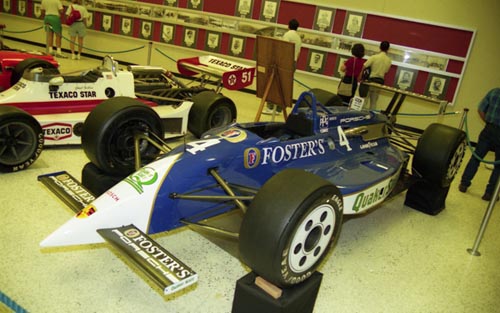
The IMS-owned 90P-002 in the Speedway Museum in 1991. In the background the Wildcat car in which Janet Guthrie finished 9th in 1978. (photo HG)
How many were there and where are they?
There is no accessible record about the number of cars built but there is strong evidence that six cars were eventually built. The last one was also the last-ever March car built in the factory at Bicester and thought to be the 1503th car built by March. The car, chassis number 90P-006, was finished mid-August.8
Regrettably, there is no detailed information currently available about the current whereabouts of the cars. A spokesman for the Indianapolis Motor Speedway Museum stated that the museum does not reveal detailed chassis information. All he could tell about the car in their possession was that it was driven by Teo Fabi. A picture of the car's chassis plate made available showed that the car in question was 90P-002 which, to the best of our knowledge, is indeed the car Fabi used during May 1990. One detail on the car is not correct. It is fitted with the open frame-type roll hoop as used in the final races of the season. During May 1990 the roll-hoop tubes were covered in bodywork as if they were an integral part of the monocoque.
'Your own' March-Porsche 90P
Scale models of the 90P do exist. The most common ones available were part of the 1:43 Onyx Indy '90 collection containing 24 of the 33 cars in the 1990 starting field. Onyx released all these cars in Europe in early 1991, America followed later on.
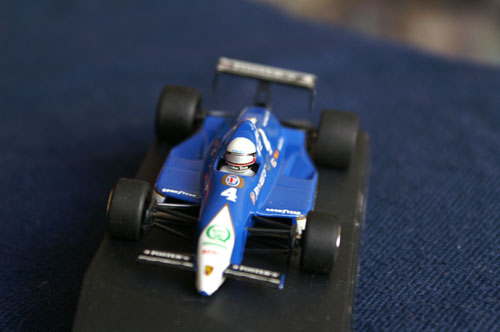
Both March-Porsches of Fabi and Andretti were available, although their quality was questionable at best. The shape of the cars was more like the 89P's, while the cars also lacked their trademark exhaust pipes and aluminium protective shield along the bodywork. But these Onyx kits were rather cheap, even in those days, and in the land of the blind a one-eyed man is king. However, the colours and decal jobs on these Onyx models are rather good and give a good indication about how the cars looked in that respect.
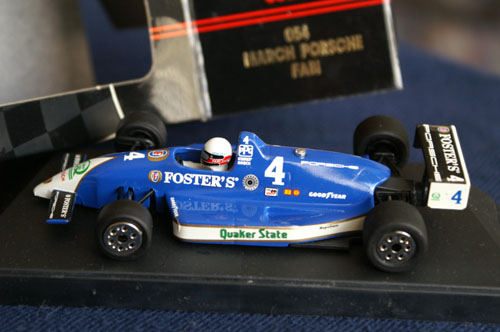
I have seen a resin 1:43 model of the 90P as well. A model company called Starter released such a model so maybe it was one of these. It must have been expensive compared to the Onyx but much more accurate and better looking…
Addition made in January 2018:
Larger scale models of the 90P became available, at least as a kit since early 2018. In the American scale-model world there are a number of small companies that produce 1:25 resin kits. Silver City Models is such a small company and in early 2018 their kit of the 90P became available. The kit doesn't contain decals for the cars. Those can be ordered at Indycals.net. (Disclaimer: Neither author nor webmaster has any interest in promoting this kit. It is mentioned only to make you aware of its existence.)
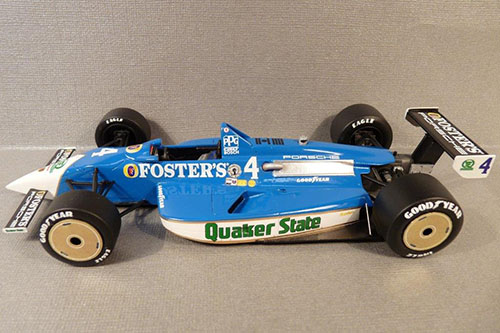
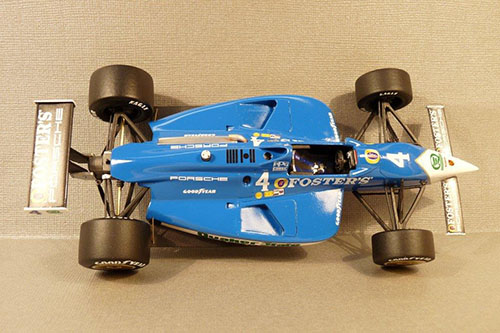
A sound registration
I think that it is obvious that since I am a Dutchman I consider myself fortunate to have attended much of 1990's Month of May at Indianapolis in person, and see Arie Luyendijk win the race. But apart from Race Day there were other unforgettable highlights at the Speedway.
In 1990 the Speedway opened new grandstands and hospitality suites alongside the front straight and called these the Tower Suites. The IMS Corporation itself also had a suite for their own use. Thanks to some unusual circumstances (with a sad background) a good friend of mine and me were invited by the IMS corporation to be their guests in their Tower Suite on Saturday May 19. This would have been the third day of qualifying but this time the pole was still up for grasps for the drivers who had not been able to make their guaranteed run. Being the guest of Mary Hulman-George and seeing Arie take the outside spot at the front row, it was red-banner day for me.
One of the things I had brought along was my pocket tape recorder, just in case I should meet interesting people for an interview.
After I wrote these pages I took up another project related to Indy 1990 and it made me check out one of the tapes I made that year. Then I found the tape I made during the Second Qualifying weekend and found a few things which I had all but forgotten. Among these was a recording.
Having watched Fabi's qualifying attempt on TV earlier during ABC's broadcast of the Indy activities that day I didn't think the March-Porsche 90P had a very special sound. But maybe that was because the car was followed from the outside of the track. Watching the car at speed from the inside of the track, however, was a different matter. The car had a distinct whistle and didn't scream as loud as the other V8 engines did.
So standing on the balcony of the IMS-owned Tower Suite, on May 19, around noon, I recorded the sound of Teo Fabi's qualifying attempt. It wasn't a hi-fi stereo recording but I still managed to convert the recording into a digital version. So here's an impression of the Pancake at high speed. I hope you don't mind the background noises nor my introduction in poor English…
The sound of Teo Fabi's qualifying attempt (WMA, 3.4 MB)
